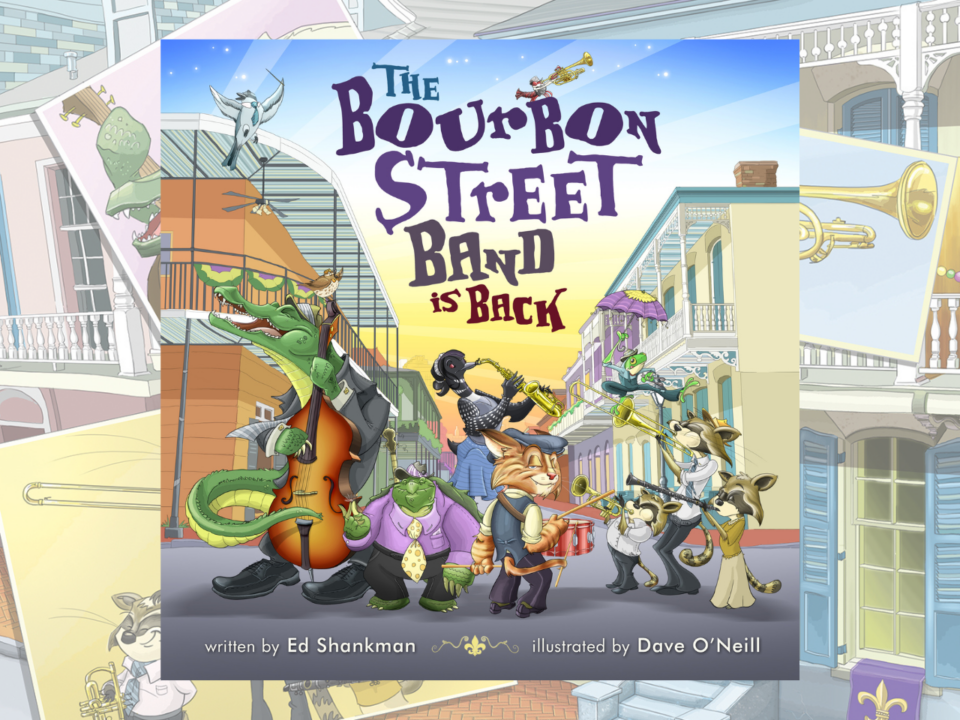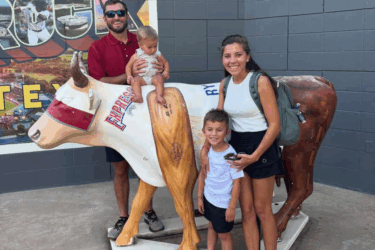The Bourbon Street Band is Back, written by Ed Shankman and illustrated by Dave O’Neill, is an eye-catching, rhyming fable set in New Orleans that discusses navigating through hardships with the healing power of music. Through their words and illustrations, Shankman and O’Neill captured the resilience and uniqueness of the city through this heartwarming story.
We recently had an opportunity to sit down with the two creatives to learn about their process, inspiration, and how music is truly one of the greatest healers of all time.
What inspired you to write this book?
Ed Shankman: First, Katrina happened, and like the entire country, I was heartbroken to hear everything that was going on. It was hard to watch. It was painful; it was upsetting. Then a few years later, there was the oil spill, and the oil spill was agonizing. Every day they were talking about the amounts of oil that were leaking into the ocean there, and again, it was very painful to listen to. Then it struck me, and I was thinking, how is New Orleans ever going to get over all this stuff? And then I was thinking, well you know, New Orleans has one thing going for it, that very few places in the world do, and that’s this incredible culture of music.
I’m a musician myself, and not just a musician, but a lifelong listener. It’s been a major part of my life. So thinking about the power of music, the healing power of music, gave me the idea for the book. And so I thought, what if we could mythologize these events in a way that even a three year old or four year old could understand? And if parents wanted to tell them, we’ve had some rough things happen here in New Orleans, but we’ve gotten over them, they could tell that story, and that’s what I tried to accomplish.
How did you come up with the characters in the story? Were their qualities inspired by anyone you know?
Shankman: I looked up the kinds of creatures, animals, and life that is in the New Orleans area, and I decided to make them into the characters. I made Bobcat Bob. A lot of what I do relates to just sound, the sound of words and wordplay, so Bob was the perfect name for a bobcat. I don’t think any of the characters were based on real people, necessarily. They were more based on the right kind of animal life and the feel of a New Orleans-style band.
Dave O’Neill: When I was creating Bobcat Bob, I put a specific hat on his head, and our publisher, at the time, was looking for a notable New Orleans musician to give a stamp of approval of some kind. They reached out to Dr. John first, and I was like, wow, that would blow my mind wide open if they got him. He wrote back to us and he said “I would, but the kind of hat he’s wearing is wrong.” So I got a note from Dr. John to change his hat. So the hat is Dr John’s. Plus, I had gone down [to New Orleans] a few times for research, for the architecture, and just to get a vibe for things. I had only been there once before, and so many of the performers my wife and I got to see, we kind of immersed ourselves for a good week. So much of it is still videos we watch, and we bought so many albums down there. The vibe of the band members are very much pulled from the folks that we got to watch. It was the best time in my life; It was great.

Are there any scenes or moments in the book that are especially meaningful to you?
O’Neill: After the darkness sets in and everyone’s kind of inside, there’s a moment where you start hearing the tap of the drum. I was racking my brain with how to come up with that and I don’t know why it took me as long as it did to realize that, like within a print medium, in cartooning, or obviously in comic books, when we write out those words, those sound effects, it started with the tap, tap, tap. When I realized that giving it the same glow effect that I gave the sun when it was coming up in their music coming out, that was kind of like a eureka moment for me, that the music itself was the highlight. So visually, it’s the wake up for me; that’s the big part.
Shankman: I was going to answer the same scene. When you hear the tap, tap, tap, you know that things are about to change, that things are about to come back. There’s something about that that’s very dramatic and emotional. I also love the line: “It’s good to cheer with all your might. And those folks clapped a lot that night. But the biggest hand in the land went to Bobcat Bob and his Bourbon Street Band.” To resolve that, with the hero band getting the biggest welcome of all, seemed like the perfect resolution.

There is a theme about the healing power of music. Why did you choose this message?
Shankman: I think the reason I came to that idea was because I was agonizing about what had happened to New Orleans, and I was looking for something positive, some way out. It occurred to me that the leading characteristic of New Orleans as an outsider, when I think of it, is the music. So that led me to the idea of the healing power of music. I also think it’s a complicated world for grown ups and for kids, and we have to deal all the time with politics and with paying bills and with family issues and illness and all sorts of things, so finding something that can be wholly positive is almost a miracle. Music is a wholly positive thing. It offers an opportunity for endless innovation. For those who play it, you can constantly reinvent and reinvent and reinvent and build on what others have done. And for those listening, it’s a neurological connection that can make us feel so many ways. So yes, maybe it’s hard paying a bill today, but a happy song will still make you feel happy, and maybe you’re feeling sad about something, and a sad song will make you feel a sense of connection to somebody else and show you that you’re not alone. So music is amazing.
O’Neill: Right around the time that Ed started writing this book was right around the time my wife, who used to do musical theater, had decided she wanted to move on to something else. And just at that time when he started writing it, she enrolled for a music therapy program. She’s a music therapist now, and a first-hand account of yeah, it’s amazing when music resonates with people, but she’s got people who can’t speak straight up singing because it unlocks something in the brain that is so unique and so completely different from your speech patterns. That kind of stuff, the healing is physical as much as it is sociological. It’s amazing. We see it all the time. It’s absolutely crazy, but it’s inspiring.
To learn more about Shankman and O’neill, visit shankmanoneill.com. You can purchase a copy of The Bourbon Street Band is Back here or at Arcadia Publishing. A portion of the proceeds from the sale of the book will be donated to the New Orleans Musicians Assistance Foundation.





